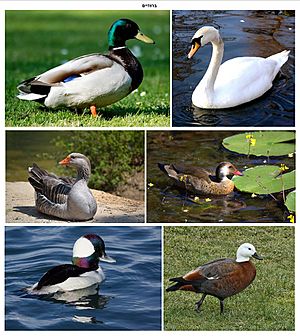Anatidae facts for kids
Quick facts for kids AnatidaeTemporal range: Early Oligocene – recent
|
|
|---|---|
 |
|
| Clockwise from top left: mallard, mute swan, Brazilian teal, paradise shelduck, bufflehead, and greylag goose | |
| Scientific classification | |
| Type species | |
| Anas platyrhynchos Linnaeus, 1758
|
Anatidae is the scientific name for a big family of birds. This family includes all the ducks, geese, and swans you see around the world. These birds are amazing swimmers and love spending time on the water. They can float easily and even dive in shallow areas.
Contents
All About Ducks, Geese, and Swans
What are Ducks, Geese, and Swans?
The Anatidae family is a group of birds that are experts at living near water. They are known for their webbed feet, which help them swim. You can find these birds almost everywhere on Earth. They live on all continents except for the very cold Antarctica. They also live on most islands and island groups. There are about 146 different kinds of ducks, geese, and swans. They belong to 43 different groups, called genera.
How They Live
These birds are perfectly built for life in the water. They can swim easily on the surface. Some species are also good at diving into shallow water. Most adult anatids are herbivores. This means they eat plants. They enjoy various water-plants. However, some species also eat fish, small sea creatures called molluscs, or water insects.
Family Life and Travel
Anatids usually breed at certain times of the year. They are often monogamous, meaning they stay with one partner for the breeding season. Many species also make long annual migrations. This means they fly to different places depending on the season. They travel to warmer areas for winter or cooler places for summer.
Ducks, Geese, and Humans
Humans have used ducks, geese, and swans for a long time. A few species have been domesticated. This means they have been raised by humans for farming. Many others are hunted for food or for fun. The soft feathers and down from ducks, eiders, and geese are very popular. They are used to make warm bedspreads, pillows, sleeping bags, and coats.
Sadly, human activities have caused problems for these birds. Since the year 1600, five types of ducks have become extinct. This means they have completely disappeared from Earth. Old bones show that humans caused many more extinctions even before that time. Today, many more species are considered threatened. This means they are at risk of disappearing.
Images for kids
-
Anatidae: Eurasian teal (Anas crecca), gadwall (Anas strepera), northern pintail (Anas acuta), mallard (Anas platyrhynchos), greater scaup (Aythya marila), long-tailed duck (Clangula hyemalis), northern shoveler (Anas clypeata), garganey (Anas querquedula), Eurasian wigeon (Anas penelope), ferruginous duck (Aythya nyroca), common goldeneye (Bucephala clangula), common merganser (Mergus merganser), smew (Mergellus albellus), tufted duck (Aythya fuligula), red-breasted merganser (Mergus serrator), common pochard (Aythya ferina). Post of Belarus, 1996.
-
A male mallard duck
-
Maned duck is the only living member of the genus Chenonetta
-
Black swan (Cygnus atratus) skeleton on display at the Museum of Osteology.
See also
 In Spanish: Anátidas para niños
In Spanish: Anátidas para niños






